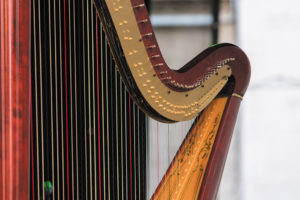A noble, ancient instrument, the harp dates back from antiquity to the present. Known to exist as far back as 3,000 B.C., some historians even trace it back to 3,500 B.C. The harp is certainly one of the oldest instruments in the world. Many ancient instruments have died out and are no longer in existence but the harp, through many permutations and construction changes, has endured through the ages to the beautiful and complex instrument we have today.
 “From medieval to modern, classical to jazz, acoustic to electric, steeped in tradition yet open to change; for many it is more than a mere instrument—it is a calling,” according to the International Harp Museum in Orlando, Florida.
“From medieval to modern, classical to jazz, acoustic to electric, steeped in tradition yet open to change; for many it is more than a mere instrument—it is a calling,” according to the International Harp Museum in Orlando, Florida.
It is thought that the earliest harps probably evolved from a bow string. The ancient Egyptian harps ranged from a small shoulder harp of seven strings to a much larger standing instrument of 22 strings.
Updated versions of the instrument appear from the 11th Century on. The first appearance of harps in Europe was in Ireland during the 12th Century. When the harp spread to the European continent it was embraced by the Troubadours, Trouveres and Minnesingers.
The Irish harp evolved in the 11th Century and initially had brass strings plucked with long fingernails. From the late Middle Ages until the 18th Century on, the harp virtually remained unchanged, except for the increased number of strings. The Irish still use the harp as a heraldic and political symbol today.
Harp Construction
The harp is triangular in shape and made primarily of wood. Woods used were willow, birch, pine, spruce and maple. The early harps had fixed strings that were limited in playing major and minor keys. The plane of the strings is perpendicular to the sound board, not parallel like the piano. Harps varied in size and some small instruments were played on the lap. In 1697, Jacob Hochbrucker of Bavaria, invented a pedal action that changed the pitch of the strings. Later, in 1720, Hochbrucker and J.P. Vetter of Nuremberg, invented a five pedal harp that raised the pitch by a half step.
Around 1810, French instrument maker Sebastien Erard, introduced the double action or double pedal harp. This allowed the harp to be played in any key. The pedals were used to raise the pitch to a half or whole tone. Operation of the pedals made all of the major and minor keys available. This invention was revolutionary as it enabled the harp to eventually become a welcome member of the symphony orchestra.
Pitch of the strings is determined by the length of string, tension and weight of string. Different colors were used on the strings to indicate the names of the pitches.
Throughout its development, the harp grew and more strings were added to the instrument. The harp evolved from a small instrument of five or six strings to a giant instrument with 47 strings, according to the Harp Foundation.
Playing Technique
The harp is played by plucking with bare fingers. Professional harpists develop calluses on their fingers as the skin thickens with constant playing and plucking. Two playing techniques are always associated with harp playing. One is the Arpeggio, a quick succession of notes in a chord played one after another, instead of simultaneously. Glissando, often used in harp playing, is a rapid sliding movement or sweep over the strings. Both techniques are characteristic, distinctive features of harp playing.
Repertory
Musicologist and historians generally agree that harp music of merit was not written until the end of the 19th Century. Harp music was mainly written by French composers. Some are: Saint-Saens, Fantasy for Violin and Harp; Debussy, Sonata for Flute, Viola and Harp; Ravel, Introduction et Allegro for Harp, String Quartet, Flute and Clarinet.
Debussy and Ravel used the harp prominently in their impressionistic music. Other famous composers who wrote for harp are: Richard Strauss, Hector Berlioz, Franz Liszt, Richard Wagner and Cesar Franck. Wolfgang Mozart wrote a Concerto for Flute and Harp and Beethoven wrote for the harp in Prometheus. Many composers used the harp in their orchestral scores.
Writing for the harp in the 20th Century included the jazz genre; even the Beatles used the harp in their 1967 song, She’s Leaving Home.
The portability of a modern harp is a challenge for harpists. The instrument is extremely large – six foot two in height and weighs in excess of 75 pounds. Transporting a harp is not done in an ordinary car; one needs a large SUV or van or a well-padded pickup-truck. If the harpist is a petite female, she usually needs some assistance in getting the harp loaded and unloaded. Also, it really needs to be protected as a new harp costs over $20,000.
One of my most memorable experiences listening to harp music, was in Chicago. We were there for a music convention around Christmas time. We love High Tea at the Drake Hotel, with the room decked out in holiday splendor. In the center of the room is a large fountain surrounded by small tables. A harpist, near the fountain, plays beautiful soft music throughout the tea. What a delightful way to spend a winter afternoon – great food, and beautiful relaxing harp music with a wonderful holiday mood. Couldn’t be better!
Another memorable experience was brunch at the beautiful, famous, Moana Hotel in Honolulu. Again, the ambiance was devine, great food with wonderful harp music to accompany the gentle swaying palm fronds, beside the blue Pacific lapping the shore in Waikiki! Aloha.
Have a Happy and Peaceful New Year!
Please submit your questions and comments to banddirector01@comcast.net and visit our website at danvilleband.org for up-to-date information about the Danville Community Band.
Leave a Reply